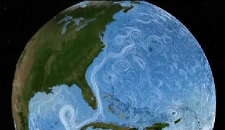|
Why is it Important to Understand Ocean Salinity?
Ocean salinity plays key roles in the global hydrological cycle, ocean circulation and in regulating Earth's climate. Today's scientists
know that Earth's water cycle is dominated by exchanges between the ocean and atmosphere, with sea surface salinity (SSS) varying
because of freshwater input and output, via the processes of evaporation and precipitation.Having a better understanding of the processes of evaporation and precipitation and how changes to these processes may influence the global hydrological cycle and ocean circulation will improve our abilities to monitor, understand and model the water cycle over the oceans. The ocean is an uncontaminated source for understanding these influences by measuring the changes in salinity and relating them to the changes we see in the water cycle. Featured Video: Why SPURS?
An Oceanographer And The Water Cycle [NASA Earth Observatory] If one wants to find out what the water cycle is doing, one should be looking at the oceans
The Water Cycle Activity [NASA Aquarius]
This activity focuses on two aspects of the water cycle: evaporation and condensation
Sea Surface Salinity and Ocean Circulation [CLIMB] The effects of sea surface salinity on ocean circulation are illustrated in this interactive concept map from COSEE-Ocean Systems Salinity Basics [NASA Aquarius]
How much salt is there? Where does it come from? Is salinity uniform throughout the ocean? Answers to these questions and more Aquarius Student Outcomes [NASA Aquarius]
Twenty three student outcomes addressed by Aquarius EPO materials and aligned with National Science Education Standards Ocean Circulation and Climate [NASA Aquarius]
Ocean salinity's influence on the environment can be summarized by looking at Earth's three major latitude zones: high latitudes, mid-latitudes, and the tropics |





